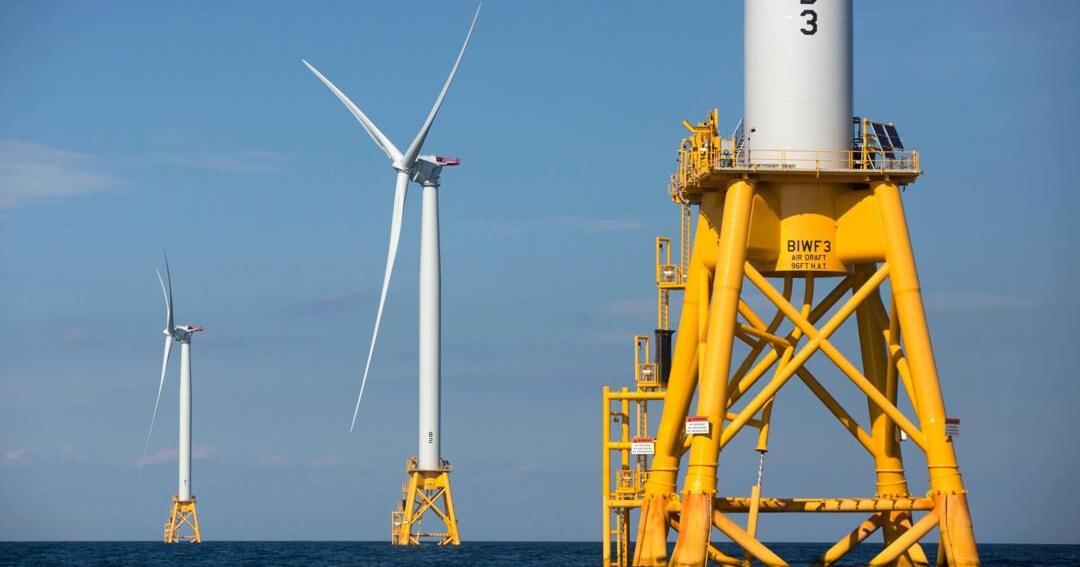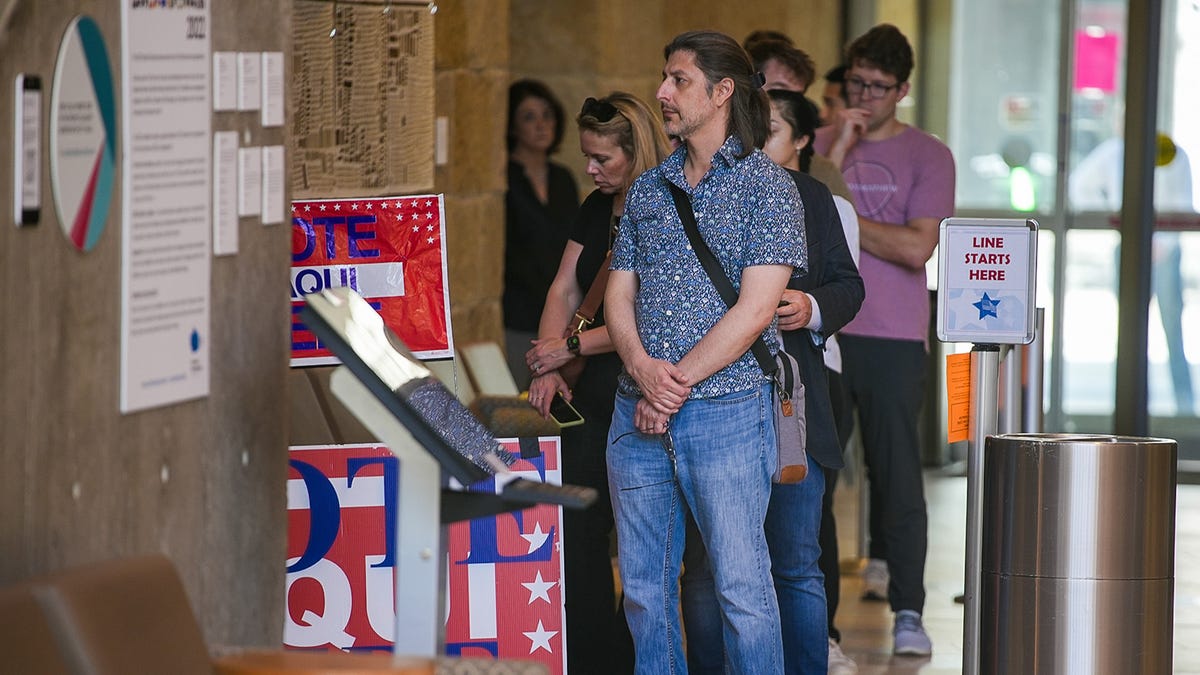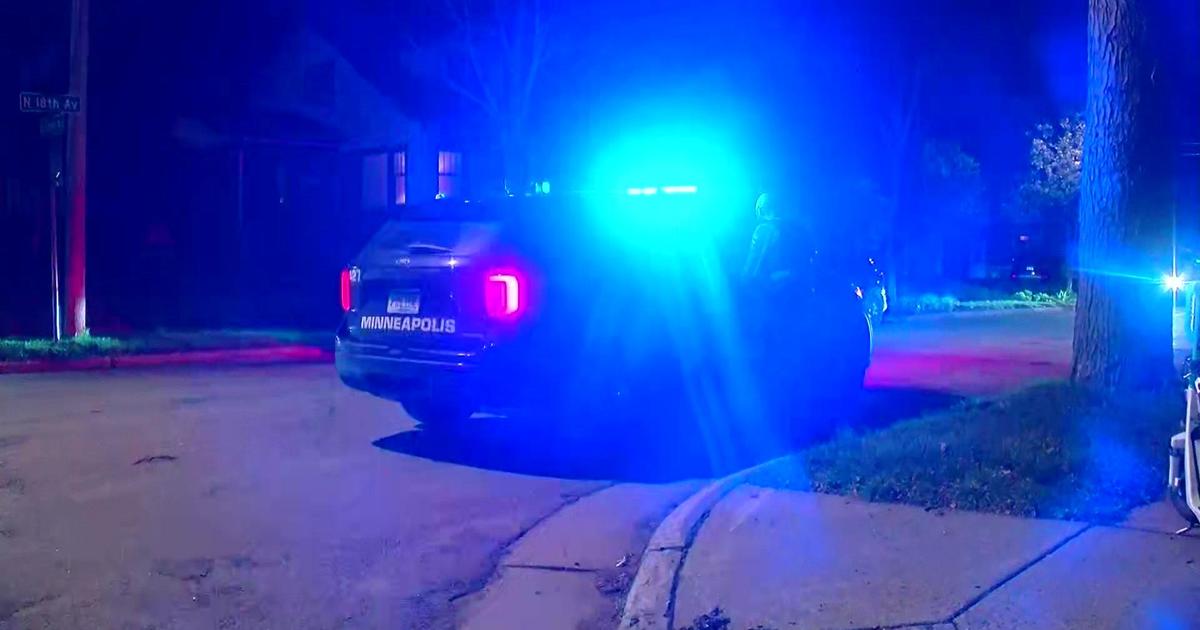Louisiana
Louisiana begins negotiations for first three wind farms in the Gulf of Mexico

Energy companies aren’t waiting for the federal government to open the Gulf of Mexico’s far offshore waters to wind development. Norwegian and Japanese wind farm developers have already offered bids for at least three projects in the nearshore waters managed by Louisiana, which offers a potentially quicker process for building the Gulf’s first wind turbines.
“We’ve had significant interest,” Gov. John Bel Edwards said of the projects. Speaking at the recent American Clean Power Conference in New Orleans, Edwards said he couldn’t identify the companies because of ongoing negotiations with the state Department of Natural Resources, but indicated companies have their eyes on two areas in Louisiana waters, which extend about three miles from the coast
“I believe they can be set up in state waters several years before they would be successful in federal waters,” said Edwards, who has made offshore wind development a key component of Louisiana’s efforts to combat climate change.
Gov. John Bel Edwards discusses offshore wind energy at the American Clean Power Conference in New Orleans on May 24, 2023.
DNR records indicate the state is negotiating offshore wind lease agreements with Mitsubishi-owned Diamond Offshore Wind and Kontiki Winds, a Norwegian company operating in Louisiana under the name Pelican Winds.
Notes from the May 10 meeting of DNR’s Mineral and Energy Board noted discussions of proposals from Diamond for waters off Terrebonne and Lafourche parishes, and a proposal from Kontiki for waters off Cameron and Vermilion parishes. The discussions were part of the meeting’s executive session and were not open to the public.
DNR staff could not discuss the proposals because they’re still under negotiation, but indicated that two companies have proposed three different wind farms. Diamond and Kontiki did not respond to requests for information.

Wind turbines in the Atlantic Ocean near Block Island, Rhode Island, were photographed in September 2021.
In September, Diamond and Entergy Corp. announced a partnership to explore offshore wind projects in the Gulf, an early step in a process that now appears to be gaining traction. Diamond is a subsidiary of Mitsubishi, a Japanese auto maker that has diversified into natural gas production and other energy enterprises. Diamond has seven commercial-scale offshore wind projects and is developing a floating wind farm project off the coast of Maine.
Kontiki has shown interest in developing floating wind farms that would power offshore oil and gas platforms. According to an agreement Kontiki signed in January with Houston-based marine engineering firm Oceaneering, the companies will collaborate on floating “micro-grid” wind projects linked to offshore platforms and small islands in the Gulf and off the coasts of Brazil and Northern Europe.
It’s unclear how large or how far offshore the wind farms proposed in Louisiana waters would be. Wind developers and state leaders expect little opposition because few people have homes on Louisiana’s marshy coast, and the Gulf’s fishing industry is already accustomed to navigating around drilling rigs and other oil and gas infrastructure. Concerns have been raised about impacts on wildlife, especially the millions of birds that migrate across the Gulf each year.

The platforms for these wind turbines in the Atlantic Ocean near Block Island, Rhode Island, were made in south Louisiana.
Federal vs. state waters
Federally managed waters, which begin where state waters end and extend 200 miles, have greater average wind speeds and more potential for large-scale projects, but companies are increasingly willing to invest in smaller-scale projects in state-owned waters thanks, in part, to a more streamlined approval process.
The U.S. Bureau of Ocean Energy Management recently cut the wind development areas in the Gulf’s federal waters by two-thirds and slowed the leasing process to allow fast-tracked plans for new oil and gas drilling.
Bidding on the Gulf’s first federal offshore lease areas is expected to begin sometime this summer. The areas will likely cover a 102,000-acre zone south of Lake Charles, and two zones near Galveston, Texas that may be trimmed down to 100,000 acres.
Wind farm developers would need to do site assessments, surveys, environmental reviews and other steps that could take much of the remaining decade. The first wind farms in federal waters likely wouldn’t begin construction until 2030.

The 262-foot-long Eco Edison offshore wind support ship is seen at LaShip in Houma on Tuesday, April 4, 2023. (Photo by Brett Duke, NOLA.com | The Times-Picayune)
Several industry representatives expressed frustration with the federal permitting process during the Clean Power conference. There’s a logjam of East Coast wind projects that could help President Joe Biden’s administration meet its goal of generating 30,000 megawatts of offshore wind energy by 2030, but so far only two wind farms are operating in U.S. waters.
“We have a lot of momentum,” said Susan Nickey, an executive with Hannon Armstrong Sustainable Infrastructure Capital, an investment company specializing in renewable energy. “But we and they need to to clear the way for real permitting and transmission reform.”
While Louisiana’s waters won’t draw the massive projects slated for the deep waters off windy New England, Edwards said his state can offer smaller projects a quicker start.
“We’ve got to start making progress much faster,” he said. “I do believe (permitting) can probably be improved. There are permitting steps that can be taken simultaneously as opposed to sequentially. There are so many things that we can do, especially around clean energy.”

American Clean Power Association CEO Jason Grumet, left, discusses offshore wind energy’s potential in Louisiana waters with Gov. John Bel Edwards at the Clean Power Conference in New Orleans on May 24, 2023.
Welcoming wind energy
Like Biden, Edwards has crafted ambitious climate goals. Edwards’ climate task force wants the state to achieve “net zero” carbon emissions by 2050. The task force wants Louisiana to get at least 5,000 megawatts of its energy from offshore wind over the next 12 years.
Edwards’ enthusiasm for offshore wind has drawn the interest of developers. Last year, Orsted and RWE, the offshore wind industry’s two biggest players, highlighted Edwards’ support in letters urging BOEM to focus federal permitting near Louisiana.
The European companies vote of confidence in Louisiana came as somewhat of a surprise because the waters off Texas have stronger, more consistent wind speeds. But Texas leaders have proposed new rules that would restrict the growth of renewable energy.
For Edwards, offshore wind means more than cleaner energy. It means jobs.

A worker uses a welder as parts are made for the 262-foot-long Eco Edison offshore wind support ship at LaShip in Houma on Tuesday, April 4, 2023. (Photo by Brett Duke, NOLA.com | The Times-Picayune)
A National Renewable Energy Laboratory study estimated that a wind project built near Lake Charles could create about 4,470 construction jobs and generate $445 million in goods and services. Once constructed, the hypothetical wind farm would support 150 jobs and an annual infusion of $14 million into the economy from operations, maintenance and materials.
Edwards noted that the skills and and resources required for offshore wind are already plentiful in Louisiana. Several steel fabrication, engineering and ship building companies that serviced Louisiana’s oil and gas industry are shifting their focus to offshore wind projects.
Six Louisiana companies helped build the country’s first wind farm, a relatively small collection of five turbines in Rhode Island’s state-managed waters. Built in 2016, the 30-megawatt Block Island Wind Farm could offer a hint of the size and scale of wind farms that could take shape in Louisiana waters in the coming years.
“Block Island was brought in (with) Louisiana companies – the jack-up rigs, the fabricators, the engineers,” Edwards said. “And we know that that’s going to work here in Louisiana.”
Winds of Change: How the Gulf of Mexico could be the next offshore wind powerhouse
The new boundaries include a 102,000-acre area south of Lake Charles, and two areas near Galveston, Texas.
A Houma shipyard is building a first-of-its-kind vessel to support the offshore wind energy boom on the East Coast.

Louisiana
Parents want school superintendent removed for holding classes in severe weather • Louisiana Illuminator

LAKE CHARLES – The school superintendent for Calcasieu Parish is facing calls for his resignation after he chose not to cancel classes April 10, when three tornados hit the area.
Shannon Lafargue defended his decision in a video statement, saying he kept schools open based on the information available to him and prioritized safety.
However, many community members are angry the superintendent did not cancel school, saying he put students, teachers and staff at risk. Bus drivers are particularly upset, as they were forced to drive through dangerous conditions, including flooded streets and winds of more than 25 mph. Bus routes were further impacted six days later when more than 30 drivers decided not to report to work in protest.
Emails the Illuminator obtained show Lafargue was aware the National Weather Service modified its risk forecast for severe storms April 10 to level 4 out of 5 as early as the morning of April 9. The worst of the weather struck between 4 a.m. and 10 a.m.
The National Weather Service confirmed three separate tornadoes touched down in the Lake Charles area on the morning of April 10. They included an EF-2 tornado with winds up to 115 mph near McNeese State University, and two EF-1 twisters in Cameron Parish.
At the April 16 Calcasieu Parish School Board meeting, District 11 representative Phylis Ayo asked for a formal investigation of how the school superintendent handled the April 10 weather event to determine where the breakdown in communication occurred.
“Something went down, and we don’t know what it is. A formal investigation needs to happen sooner rather than later,” Ayo said.
A unanimous board vote was needed to add an item to the meeting’s agenda for the proposed investigation. District 8 Representative Eric Tarver said he would not support the motion, drawing boos from the standing-room-only audience. Board members Billy Breaux, Glenda Gay and Dean Roberts also voted against the agenda change.
At a special board meeting April 30, Lafargue recommended school board members approve a delayed school start protocol for future weather events. Bus drivers also got the opportunity to air their grievances, with many saying Lafargue owed them an apology.
Bus driver Sharon Welcome said school district officials have previously failed to prioritize the safety of bus drivers, students and teachers during severe weather.
“It’s not the first time. It’s not the fourth or the fifth time that something like this has happened. Enough is enough,” Welcome said. “I’m not going to jeopardize myself for your negligence.”
“The buck stops with you, bus drivers,” Kathy Landry, district representative for the Louisiana School Bus Operators Association, told drivers in the audience. “As your rep, anytime you don’t feel it’s safe to drive that bus, you don’t have to, and the federal government will back us on that one.”
Corey Arvie said he had seven students on board when the severe weather struck April 10. The conditions left them stuck in the middle of the road, less than 2 miles away from the tornado that struck Ryan Street. Arvie said his bus was facing toward the wind, and he worried about tree limbs crashing through his windshield.
“Today marks 20 days that I’ve dealt with trauma, crying out of nowhere, trying to earn the trust of parents again to be their bus driver,” Arvie said. “It’s hard getting up every morning knowing that these parents are trusting us with their kids’ lives, and any wrong turn, any little mistake can cost a life. It’s hard for us to keep going right now.”
Arvie said bus drivers should be represented on the school board and among school district leadership.
“I really do feel like … there should be a bus driver, either on the crisis team, in an office, because no one knows what we go through on a day-to-day basis.”
Teri Johnson, a Southwest Louisiana Federation of Teachers and School Employees representative, asked Lafargue to apologize to those in the audience.
“I haven’t earned your trust. I’m going to do something about it tonight,” Lafargue responded. “It may be too late, but at least from this point forward, no matter what happens to me, our district is going to be better … You voiced your opinion. I said in that video, that didn’t resonate with you, that this will never happen again. You are the most valuable people … I take full responsibility, and everything that goes with that is an apology.”
The school board approved a delayed start policy that would go into effect when severe weather threatens, allowing school to begin as late as 10 a.m.
According to District 10 School Board member Tony O’Banion, the board has received evaluation forms that would decide Lafargue’s future with the system. He told the Illuminator the board will go into executive session during its May 14 meeting to discuss the evaluations and will decide whether Lafargue’s contract will be renewed by June 30.
Louisiana
Special education, income quotas could be removed for charter school enrollment • Louisiana Illuminator

Louisiana charter schools might soon be able to remove certain enrollment requirements for students with disabilities and economically disadvantaged students. It’s a move that parents of those students feel limits their options in a school system based on choice.
House Bill 708, authored by Rep. Barbara Freiberg, R-Baton Rouge, moved out of the Senate Education Committee on Wednesday, despite initial pushback from some committee members and the public. It heads next to the Senate floor and, if approved, would have to go back to the House for concurrence on a committee amendment.
In 2015, former Sen. Dan Claitor authored a bill to add the language to state law that Freiberg is trying to remove. Claitor spoke to the committee in opposition to Freiberg’s bill.
Under Claitor’s bill, certain charter schools must have a percentage of students equal to 85% of the disabled or economically disadvantaged students in the local school district.
For example, if 55% of a local school district’s population is economically disadvantaged students, 46.75% of the charter school’s enrollment must be economically disadvantaged students.
Sen. Beth Mizell, R-Franklinton, questioned the reasoning behind Freiberg’s bill.
“I am a hundred percent charter, but I don’t understand the resistance,” Mizell said. “I don’t understand taking the rule out that gave us the only protection saying charters are absolutely fair across the board.”
Proponents of Freiberg’s bill said the quotas are unfair because charter schools are held to a higher standard than other public schools. Standard public schools are not required to enroll a certain number of students with disabilities or economic disadvantages.
“The quotas only give people who have an ax to grind an ability to go in to be able to cause harm,” said Kenneth Campbell, previously the executive director of charter schools for the Louisiana Department of Education.
Some charter schools have selective admissions and have resisted providing special education services, although they’re required at public schools under state and federal law.
GET THE MORNING HEADLINES DELIVERED TO YOUR INBOX
Proponents also argued it is not fair to require that parents provide their household income or children’s disability details on charter school applications when public schools do not require the same information for enrollment.
Opponents of the bill reminded the committee that since Claitor’s law was enacted in 2015, the number of charter schools in compliance with the enrollment quotas has increased but is still not adequate.
According to a Louisiana Legislative Auditor report in 2022, 10.3% of charter schools required to serve a specific number of economically disadvantaged students did not meet the requirements. The rate is an improvement from the 2016-17 school year, when 21.3% charters did not reach their quota.
The report also says multiple schools repeatedly failed to meet the economically disadvantaged requirement. It did not include information on how many schools were meeting the requirement for students with disabilities.
Opponents of Freiberg’s bill were also concerned that removing the quota would allow “bad actors.”
“If we remove that requirement for charter schools to even serve those populations, there are going to be schools that figure out ways to avoid serving those children,” said Tania Nyman, an education advocate from East Baton Rouge Parish. “And that is not going to be beneficial for the community at large.”
Although the proposal removes “goal lines” for charter schools, it still requires the Board of Elementary and Secondary Education to create rules and regulations to oversee charter schools in this capacity. The stipulation was added as an amendment in committee.
Ashley Townsend, deputy policy chief for the Louisiana Department of Education, explained to committee members that BESE would essentially create a complaint process for parents to turn to if they feel that a charter school is discriminating against children with disabilities or those who are economically disadvantaged.
Ben Lemoine, BESE’s executive director of governmental relations, indicated that board members support Freiberg’s legislation.
Louisiana
A boy gave his only dollar to someone he mistook as homeless. In exchange, the businessman rewarded him for his generosity.

Baton Rouge, Louisiana — Matt Busbice and his partners have built and sold several outdoor companies worth hundreds of millions of dollars. But Busbice, the 42-year-old owner of sporting goods store BuckFeather in Baton Rouge, Louisiana, says he has never felt richer than he did the day he received a single dollar.
“I haven’t had that much faith in humanity in a very long time,” Busbice said.
He says it all began about a month ago. It was early morning, and the fire alarm was going off inside his condo complex. So, Busbice shot out of bed and raced down the stairs only to discover there was no fire. But he was awake now, so even though he was wearing mismatched clothes and was disheveled, he decided to go out for a cup of coffee.
As he was about to enter the coffee shop, he remembered he hadn’t done his morning prayer. So as the security camera shows, Busbice stepped to the corner of the patio to pray.
“And I started to slowly open my eyes, and there’s a kid coming at me, about my height,” Busbice said.
The boy had his fist clenched, so Busbice prepared for a confrontation. But instead, the boy opened his fist to reveal a $1 bill.
“And I go, ‘What?’” Busbice said.
“‘If you’re homeless, here’s a dollar,’” 9-year-old Kelvin Ellis Jr. recalls telling Busbice. “…I always wanted to help a homeless person, and I finally had the opportunity.”
Ellis says he had just gotten the dollar for good grades. It was the only money he had to his name. Busbice was so touched, he invited Ellis in for a snack and then connected with Ellis’ father, who was next door, and promised to stay in touch.
As a reward for his kindness, Busbice gave Ellis a shopping spree — 40 seconds to pick out whatever he wanted in BuckFeather, including a new bike. Ellis says it was great, but definitely not what he wanted to get for his dollar.
“Joy, because I helped someone,” Ellis said. “Give something away, and you feel like you’ve got a lot of things from it.”
“If you give, you’re actually going to get more out of that,” Busbice said. “I couldn’t grasp that as a kid. And if we can spread that around, everything changes.”
-

 News1 week ago
News1 week agoLarry Webb’s deathbed confession solves 2000 cold case murder of Susan and Natasha Carter, 10, whose remains were found hours after he died
-

 News1 week ago
News1 week agoFirst cargo ship passes through new channel since Baltimore bridge collapse
-

 World1 week ago
World1 week agoHaiti Prime Minister Ariel Henry resigns, transitional council takes power
-

 World1 week ago
World1 week agoSpanish PM Pedro Sanchez suspends public duties to 'reflect'
-

 World1 week ago
World1 week agoUS secretly sent long-range ATACMS weapons to Ukraine
-

 News1 week ago
News1 week agoAmerican Airlines passenger alleges discrimination over use of first-class restroom
-

 Movie Reviews1 week ago
Movie Reviews1 week agoHumane (2024) – Movie Review
-

 Education1 week ago
Education1 week agoVideo: Johnson Condemns Pro-Palestinian Protests at Columbia University















